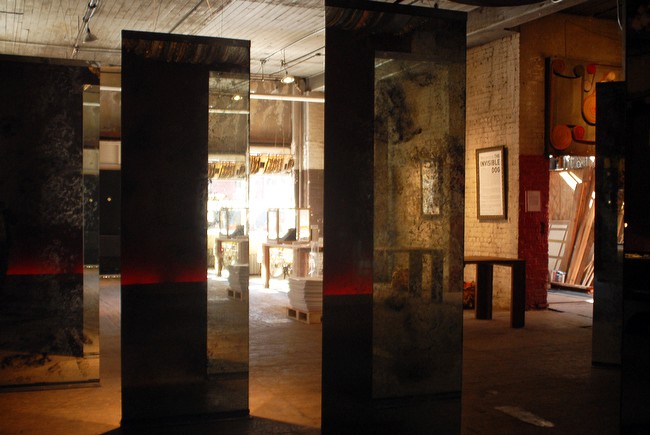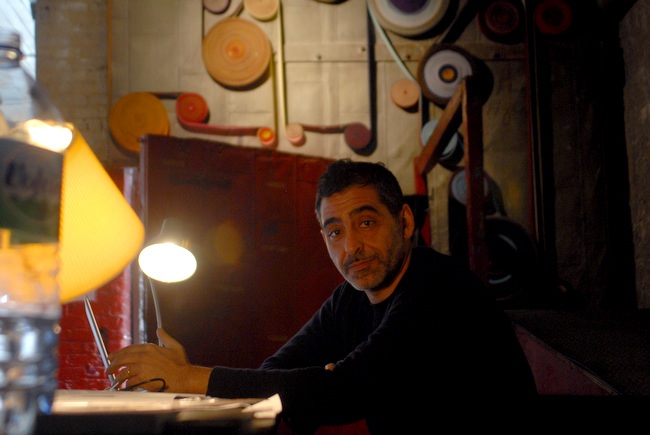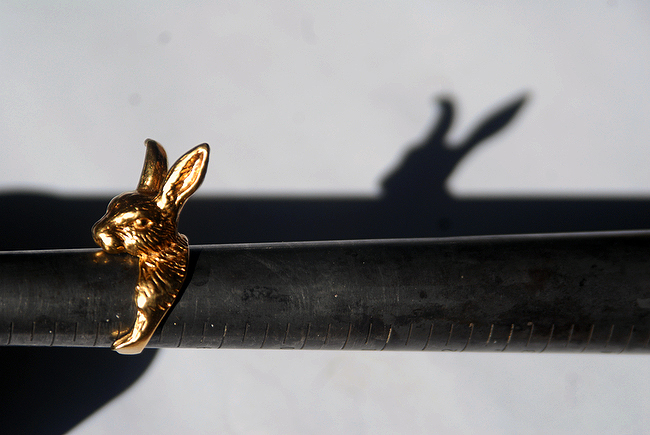
Invisible Dog Director, and Creator, the Parisien Lucien Zayan
Photo by Joshua Kristal
Photos by Joshua Kristal
I’m in a dark wooden room thick with fog and the sweet scent of fog machines. The fog is disorienting. In front of me is a shiny, translucent mother-of-pearl-like sculpture of a naked man, towering, lit brightly from within. The sound of a heartbeat gets louder and louder as the light progressively illuminates the naked man, and then goes quiet as the room goes dark. It’s a lot to take in, and I catch my breath.
A young guy with a ponytail and a flashlight in his mouth is working in the corner on a machine; red lines across a screen and lots of buttons. Apparently, there’s an electrical problem with this light installation by Thierry Dreyfus, a French artist who has designed light installations for Calvin Klein and Yves Saint Laurent fashion shows, and installed beautiful sculptures in lovely buildings, such as the Grand Palais in Paris.
But this is The Invisible Dog art gallery, on Bergen between Court and Smith streets.

Da Loba’s Creations Often End Up as Illustrations in magazines we read.
A friends of mine said, “What? The Invisible Dog? I haven’t heard of that.â€
It’s high time everyone living in Cobble Hill, Carroll Gardens, Boerum Hill and the surrounding area knows of The Invisible Dog.
The cavernous, 30,000 square-foot gallery and exhibition space in a converted 1800’s factory, opened by Paris transplant Lucien Zayan, sort of burst onto the NYC arts scene in late 2009 with a packed schedule of exhibits, installations, group and solo shows, art and urban farming/sustainability festivals, experimental film and multi-media, theater and performance, art-making camps for kids and the like.
And while it is a community arts center, it’s not a “community arts†center in so many ways—most of Invisible Dog’s shows are reviewed in The New York Times and a host of other media including Wallpaper, New York Magazine, publications in France and elsewhere. It draws well-considered artists from all over the world.
Between September and December, 32,000 people visited the gallery. Â Nearly 700 people came to a science camp recently for kids and their parents, and 1,700 people visited the Dreyfus installation. I was going to recommend that you visit it, as well; but alas, in its last week, shortly after I was awe-inspired with fog and nakedness and disorientation, the structure blew a fuse and burned to the ground. Ah, the risks of electric art.

Thierry Dreyfus’ Clouded Mirror Installation Contained Surprises for Viewers
This weekend will be the perfect time to check out South Brooklyn’s gem of a gallery. The Invisible Dog is launching three new shows on March 5. For the first time, the 30 resident artists – including art stars from 12 countries, including Cuba, Portugal, Greece, Italy and Korea — will exhibit as a group on the large, 4,000 square foot, third-floor space. On the second-floor, the artists’ studios will open for tour.  On the ground floor, installation sculptor Chris Klapper and electrical engineer Jen Lusker have created an interactive light installation consisting of 2,000 hand-cast spheres spanning a 20-foot wall.
In the basement, installation artist Julien Gardair‘s Camera Locus 2 will be on view. Since January, the Brooklyn artist, born in Versailles, delved into the history of the old factory-turned-art haven to create a site-specific video installation featuring photographs, drawings, video and animations.
There’s a lot going on, and that’s just how gallery director Zayan likes it.

Pied Piper Lucien Zayan Brings Global Art to Bergen Street
Zayan is a quirky, charismatic figure who thinks big and likes large, airy, edgy exhibits–a luxury of space, and a fresh departure from more predictable gallery fare. He meets me on a Friday night to tour his massive space.
Zayan tells me the idea for Invisible Dog came to him in a flash. He says he never thought of opening a gallery until he was visiting New York and staying in the neighborhood, and walked by this huge abandoned warehouse on Bergen.
Zayan spent his life working in theater and opera, with the Aix-en-Provence festival and Paris’s renowned Théà tre de Odeon and Théà tre de la Madeleine, and, as it says on the gallery website, he “recognized the perfect mise-en-scène,” when he saw 51 Bergen. With the support of the building’s owners, who he calls the “perfect partners,” he decided to turn the space into an art center.
“The idea came to me at that moment. The project was inspired by the building. Two minutes before I thought of it, I had no idea of that.â€
At that time, in 2008, the building was packed full of stuff and junk and furniture. All 68 windows were broken and needed to be replaced.  It was an old belt factory that in the 1970s was converted into a factory making “invisible dog,†leashes—a 1970s fad in which people walked around with a stiff leash that did not have a dog at the end of it.
 I remember a day about a year ago, when dozens of people walked around Carroll Gardens and Cobble Hill holding the leashes, and pretending like nothing was happening. Surely, Zayan’s work.
I remember a day about a year ago, when dozens of people walked around Carroll Gardens and Cobble Hill holding the leashes, and pretending like nothing was happening. Surely, Zayan’s work.
When the Invisible Dog opened in October 2009, New York City was in the throes of the recession. Zayan’s concept was to use money raised from artists’ studio rentals, and renting the special event space, to pay the rent. “Nobody knows me here, so it was impossible to apply for grants,†Zayan says.
The gallery gets zero grant dollars, or money from the city.
Since the Invisible Dog opened, there’s been a renaissance on Bergen.
“Bergen was a scary street. It was empty. The subway is there. But now, there are much more people, two new restaurants, Fork + Pencil antique store, and the Laundromat across the street, that is essential. In one year, the street changed a lot.â€
 Zayan says his goal was to create a space that artists used for work and creation. Steven and Willliam Ladd built a chandelier hanging over the ground floor gallery using 10,000 belt buckles left in the warehouse. Artist Ian Trask built a permanent installation over the massive industrial elevator using belt material. An Italian artist painted the interior of the elevator shaft with text from Dante’s Inferno.
Zayan says his goal was to create a space that artists used for work and creation. Steven and Willliam Ladd built a chandelier hanging over the ground floor gallery using 10,000 belt buckles left in the warehouse. Artist Ian Trask built a permanent installation over the massive industrial elevator using belt material. An Italian artist painted the interior of the elevator shaft with text from Dante’s Inferno.
Zayan is a pied piper of sorts, and attracts all kinds of international artists to his gallery. While 30 artists rent studios, 50 people work at Invisible Dog on any given day, making jewelry, illustrating books and greeting cards, painting, sculpting, welding medal. Unlike most artists’ workspaces, Zayan selects residents only after viewing their work. Recently he had five spaces open; they rented within two weeks, he said.
Invisible Dog’s impressive roster of resident artists includes the incredibly-talented designer and illustrator Andre da Loba, whose work you will likely recognize from its frequent and prominent appearances in The New York Times, Time Out, Time Magazine, The Boston Globe, and elsewhere.
Da Loba, who is originally from a small town in Portugal, says he was one of the first artists to rent a studio at Invisible Dog.
“For everyone, this is a job, so everyone is respectful,†da Loba says. “We do what we want, when we want.  You never know what to expect. Sometimes there will be a musician playing downstairs, a wedding upstairs, there’s always something going on, jazz concert, theater, film. It makes it fun.â€
The last time the Invisible Dog held an open studio, 500 people walked through da Loba’s work space, he said.

Chong Gon Byun, a resident artist at Invisible Dog.
In another studio resides Chong Gon Byun, one of Korea’s most famous artists, and an art icon there. His shows pull fans from Korea, Japan and beyond.
Zayan takes me to painter Giles Lyon’s studio. Lyon says he was priced out of an artist’s studio in Dumbo, and stumbled onto the Invisible Dog Gallery when visiting the Muriel Guepin Gallery next door.
Lyon says Zayan has a different way of running things.
“I’ve rented studios for 15 years, and never had a landlord say, ‘Let me see your slides first.’ They just want your bank account.â€
“It’s a vibrant community, with lots of exchange and opportunities, and it’s very, very supportive,†Lyon said.
Lyon shows me his window on the side of the building, which during the warm months displays a big tree and billows of lush honeysuckle. Down below, in the yard, an artist is making a huge compost pile that he uses to make artwork, on canvas.  When the vegetables dry, it leaves a design on the canvas, Zayan says. “He even made an American flag,†with it, Zayan said.
In summer, you can swing by and pick up compost for your garden, with a $1 or $2 donation.
Zayan says he’d like to create a “priest’s garden,†in the gallery’s lovely and sizeable back courtyard.
Lyon says he’d like to grow mushrooms.
“This is an excellent environment for mushroom, Shitake and Oyster. Mushrooms are not plants. They are animals. Mushrooms and humans have more in common than anything else.â€
I had not heard this before.
Lyon shows me his sculptures, which are made with his wife’s hair and remnants of his meals: an olive pit, a tiny eel skeleton.

A ring by artist Aaron Ruff, of Digby & Iona, made at Invisible Dog
We head up to the third floor—a vast open space with big windows on either end, that Zayan rents out for weddings and special events. In coming weeks, he will host the fundraisers for PS 29, PS 58 and PS 261 there.
“It all happens organically,†Zayan says.
We sit down to chat. The gallery gets a lot of press in France, Zayan says, and so, about 10 percent of visitors are tourists. Some 30 percent are from Manhattan, and 60 percent from Brooklyn.
Zayan says people gave him a hard time about naming the gallery Invisible Dog, as it’s an unknown thing in Europe, where most of his contacts reside.
“This is the history of the building. It is part of American culture,” Zayan says of the invisible dog chains, which are sold at the gallery for $25. “Everyone remembers that. It is even on the Simpsons, they have an invisible dog.â€
When a gallery is buzzing with exciting art, now is the time to visit. Who’s to say if the Invisible Dog, with our ever-increasing property values, will stay in the hood.
“It’s very, very important that we build an audience with people and the neighborhood, and a real relationship. Most important is to create a spirit. I don’t know what will happen in a few years. Maybe we’ll move somewhere else. It’s easier to travel with spirit than with luggage.â€
open studios
Sat March 5 from 11am to 10pm
Sun March 6 from 1pm to 5pm
opening party exhibition
Sat March 5 from 6pm to 10pm
The Invisible Dog Art Center
51 Bergen Street, between Smith and Court
Open Thursday to Saturday
1pm to 7pm
Sunday 1pm to 5pm
Tuesday and Wednesday by appointement only
Closed on Monday
347-560-DOG [364]-1
theinvisibledog.ny@gmail.com
theinvisibledog.org
